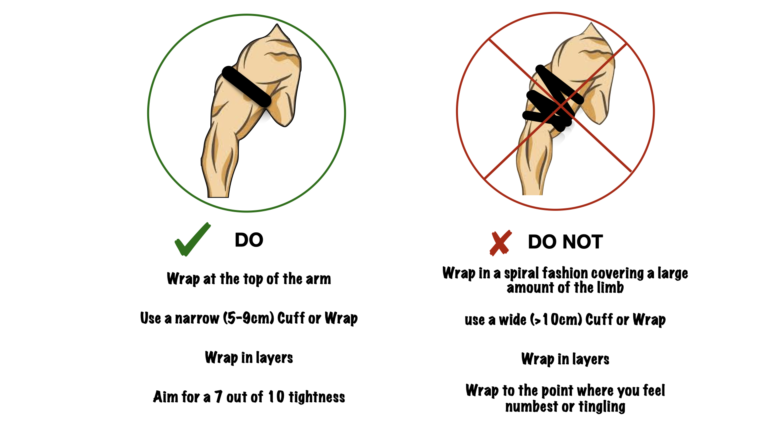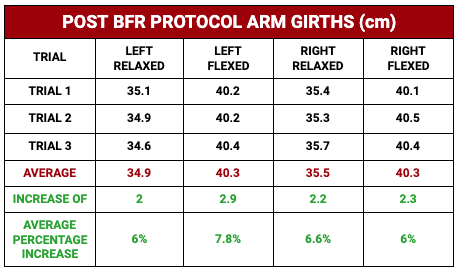N=1 CASE STUDY: CAN BLOOD FLOW RESTRICTION TRAINING INCREASE MUSCLE MASS?
START YOUR JOURNEY TO BETTER PERFORMANCE NOW

By GARETH LYNCH
Are you looking for a fast and effective way to increase muscle mass?
Have you been struggling to break through a plateau, have little weight available or are you just looking to try something new? Blood Flow Restriction (BFR) training could be the answer you are looking for.
I have conducted a self case study to discover and share what results a BFR training protocol could have on increasing muscle mass in the upper arm. The protocol I used helped me to increase the size of my arms by 6.6% or 2.3cm in just four weeks.
Keep reading to find out what exactly is BFR? How does it work? What exactly I did and what the exact results were.
SO WHAT IS BLOOD FLOW RESTRICTION?
Blood flow restriction or BFR training has been around a long time in the bodybuilding world and is commonly used in the rehabilitation of injured professional athletes but is only now gaining some real traction with everyday gym enthusiasts. BFR allows you to quickly pack on lean muscle mass and size without having to use heavier loading. Not using heavy loads that induce prolonged muscle soreness allows you to train more often. BFR has a lot to offer whether you want to quickly gain lean muscle mass, increase your training frequency, try something new in your programming or just want to feel a hell of a pump.
BFR training is essentially a strategy that involves the use of cuffs or wraps placed around a limb during exercise. The aim is to allow blood to enter the muscle via arterial flow (oxygenated blood coming from the heart), but partially restrict the venous blood from leaving the working muscle. Since the ability of that returning blood to escape is reduced, metabolic stress and cellular swelling are greatly increased. As a result, you have an increase in the activation of the mTOR signaling pathways, which lead to enhancements of muscle protein synthesis. These adaptations allow muscle hypertrophy to occur, letting you gain lean muscle mass quickly (1,2).
Over the years BFR has adopted many different names. The term occlusion training is often used interchangeably with blood flow restriction training. BFR is also often referred to as hypoxic training or KAATSU. KAATSU is a patented training device that was developed by Dr. Yoshiaki Sato, who is credited with popularising BFR training.Sato originally experimented on himself by applying different bicycle tubes, ropes and bands on different parts of his body.
SO WHY IS BFR BENEFICIAL?
To increase lean muscle mass you either need to induce mechanical (usually done with heavy weights) or metabolic stress in order to stimulate growth.
BFR training creates a high metabolic stress in the muscle. It increases your inflammatory and endocrine response, cellular swelling, elevates intramuscular inorganic phosphate and boosts muscle protein synthesis, all of which have been shown to directly stimulate muscle growth. BFR training and the direct muscular fatigue it causes, also induce the nervous system to recruit the largest fast-twitch muscle fibers, which have the greatest capacity to grow in size (3,4).
So if you are someone looking to increase your muscle mass BFR training could be your answer

SO WHAT DO YOU NEED FOR BFR TRAINING?
Inflatable cuffs that allow for strict control, are commonly used in research and professional settings. However, these devices may not be practical for you, if you don’t want to shell out a lot of money. They come with a high price tag and are not straightforward to use, with some devices requiring you to get a certification before use. A more practical option to these devices is the use of elasticated wrap (Here are the ones I used). While BFR with elastic wraps does not allow for strict control of the pressure, it does provide a safe, effective occlusive stimulus.
If using BFR wraps, research has shown that you want to tie the BFR wraps to a perceived pressure of 7 out of 10. This results in venous restriction, but not arterial. Training at a 7 out of 10 perceived pressure has been shown to drastically increase cell swelling, recruit more muscle, and had a large amount of metabolic stress. If you tie the wraps too tight there are potential negative effects. You can cause arterial occlusion which may actually decrease muscle growth at the site wrapped (5).
I suggest using narrower wraps with a width of 5-9cm. This reduces the risk of fully occluding the arteries (which leads to negative training effects), compared to a wider cuff or wrap. For this reason, I also recommend wrapping in a layered manner rather than wrapping in a spiral manner.
WHAT DOES A BFR PROTOCOL LOOK LIKE?
There has been a wide variety of BFR training protocols used across the research. Researchers have used varying one repetition maximum (RM) values from 20% to 50% 1RM for their protocols with each showing positive results. The number of repetitions and sets used also fluctuates across the research ranging from 20 repetitions to maximum effort exhaustion.
Some of the most common are a 30-20-20-20 repetition scheme with 45s interset rest at 20% of your 1 repetition maximum (RM) or 4-5 sets to failure with 30s interset rest at 20-30% 1RM. These programmes are generally 2-4 sessions per week and can last anywhere from 2-12 weeks (6,7,8,9,10,11).

THE BFR PROTOCOL I USED?
The exact training programme that I recently followed increased the girth on my arms by one inch (an average of 6.6% increase in both relaxed and flexed measurements) in just 12 sessions was 3 sets to failure with 30s interset rest at 50% 1RM. I selected two exercises to isolate the biceps and two exercises to isolate the triceps. There was a 90-120 seconds rest between exercises where the cuffs were released and I completed three sessions a week for four weeks.
The two exercises I selected to isolate the biceps were dumbbell hammer curls and dumbbell preacher curls and dumbbell skullcrushers and dumbbell close-grip bench press were chosen to isolate the triceps.
The first set began with seated dumbbell hammer curls three sets to failure with 30s break. At the end of the three sets I released the wraps and took a 90s break before starting the next bicep exercise with the wraps tightened. Once The second bicep exercise was completed, the wraps were loosened and a 2 minute break was taken before starting the same process again with the two tricep exercises.
A goal you can aim for is to complete in the range of 20-30reps in set 1, 15-25reps in set 2 and 5-15reps set 3.
While you may feel a lot of tension and swelling in your muscles while lifting the weights, it doesn’t and shouldn’t hurt. You should start to feel your muscle swelling and then you feel ‘the burn’. As Arnie would say “feel the pump!”. Towards the end of each set you might feel like your muscles are going to explode but don’t worry, once you release the wrap you get an instant sense of relief and euphoria as the blood rushes around.

TAKE HOME POINTS
BFR is an effective method for increasing muscle mass.
Narrow wraps, tied in a layer fashion are best.
Tie the warps to a perceived pressure of 7 out of 10.
Tying the wraps too tight can lead to negative adaptations.
BFR should be used as part of a balanced periodised programme, it is not a panacea.
FINAL NOTE
BFR training is a great modality for stimulating muscle growth but as it only provides a low mechanical stress it is not likely to excessively stress connective tissues, tendons and ligaments. This means BFR training must be cycled with heavier resistance training to ensure that mechanical stress is being placed on the tendons to reduce the risk of subsequent tendon injuries.
Inappropriate use of blood flow restriction can result in detrimental effects, including rhabdomyolysis, petechial haemorrhage (i.e. severe bruising) and dizziness. It is also worth noting that very prolonged use of BFR can lead to the breakdown of muscle tissue. As such, it may be sensible to avoid performing continuous blood flow restriction training for very prolonged periods of time.
REFERENCES
Takarada, Y., Sato, Y. and Ishii, N., 2002. Effects of resistance exercise combined with vascular occlusion on muscle function in athletes. European journal of applied physiology, 86(4), pp.308-314.



